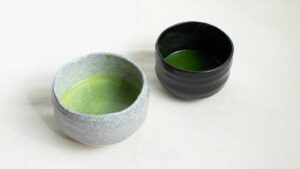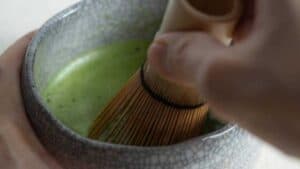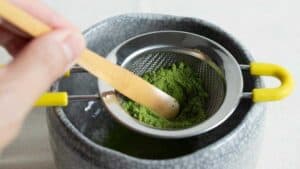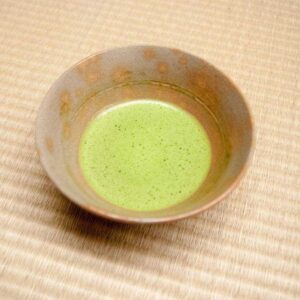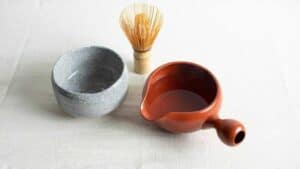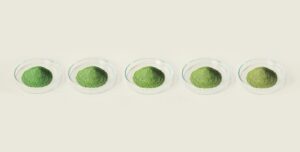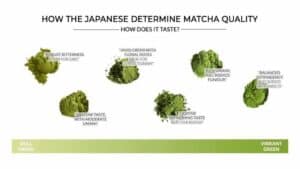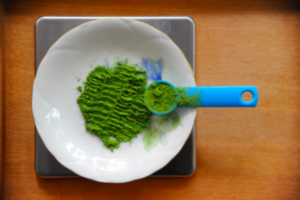Tag: ผงมัทฉะ
Difference between KOICHA and USUCHA
Have you ever wondered why some green tea shops have a strong taste while others have a very weak taste, even though they use the same matcha powder? That’s because there are actually two ways to brew green tea in Japanese culture, called Usucha and Koicha. These are traditional ways of preparing matcha that originate from the Chado ceremony, a Japanese tea ceremony.
If we translate it directly from Japanese, Usucha means “light tea”, while Koicha means “strong tea”. It may not be easy to understand, but the meaning is straightforward. Usucha matcha has a thick layer of foam on the surface, which can be easily achieved by beating the tea with a tea brush. The taste is smooth. When you first drink it, it is sweet and bitter, but when you swallow it, you will get the umami taste. It is brewed in a small cup for one person, so the tea has a mild and slightly bitter taste. In the old tea ceremony, this type of tea was eaten with Higashi Japanese sweets, but nowadays it is eaten with namagashi, such as mochi, dango, nerikiri, and yokan.
On the other hand, Koicha matcha is much more concentrated and has an umami flavor that may be too strong for beginners to drink. This is because Koicha requires about twice the amount of matcha powder and half the amount of water compared to Usucha. Because in the tea ceremony, Koicha is brewed in a large container, so it can be drunk by many people, it needs to be brewed to have a stronger flavor.
It can be seen that in the two traditional styles of matcha brewing, the highest quality matcha is preferred for the ceremony, that is, using tea powder where the tea leaves are covered with leaves, to be exposed to the least amount of sunlight for the first 20 days or so. This period is calculated from the time when the first buds start to sprout. This covering to block the sunlight prevents the sweetness in the leaves and limits the bitterness that can be produced. The tea leaves are harvested by skilled hand pickers to maintain the quality of the tea leaves until the final stage. Because after picking the tea leaves, they must be steamed to prevent oxidation of the tea leaves and maintain their green color and freshness.
Then, it is dried and sorted to prepare for grinding with a large granite mortar into a fine tea powder called matcha [抹茶]. Whether the mortar is turned manually or automatically, the amount of tea powder that can be collected per hour is only forty grams. The best quality tea leaves are made from the top young leaves, so the production is labor-intensive, which inevitably makes the price relatively high.
Green tea is a beverage that has been with the Japanese for a long time. It is used in many important events, such as welcoming important guests, birthdays, or changing seasons, to truly experience the taste of drinking tea. However, making your own usucha and koicha does not make the activity a complete matcha tea ceremony in the Japanese style. This is because the actual ceremony has many other steps that are quite complicated.
Therefore, some cafes nowadays use the names of these two types of tea brewing as the names of their menus to help customers understand the taste and strength of the tea. There is no traditional Japanese tea ceremony when serving it.
However, even though Usucha tea is a light tea with a not very strong flavor, it may still be too strong for those who have never tried matcha. If you are not a regular tea drinker, it is recommended that you start with Matcha Latte first, or if you are using pure matcha, you should brew it weaker than the original Usucha.
How to prepare Usucha and Koicha
To make Usucha, mix 1 teaspoon of matcha powder with 60 ml of hot water and quickly whip the matcha in an M shape until dissolved. Repeat until the matcha has a thick foam with many small bubbles. Finish by whipping in a circle and lifting the matcha from the center of the bowl.
For concentrated Koicha, use 2 spoons of matcha powder with 30 ml of hot water and slowly stir in a circle until dissolved. Avoid creating bubbles to obtain a concentrated matcha with a consistent taste. The water used to brew both types of tea should be 85 degrees hot water, which is enough. This is another precaution to maintain the best taste of tea because each type of tea is suitable for different water. (Read more at https://bit.ly/3tWmvZj ) In addition to the temperature precautions, the water used to brew matcha does not need to be mineral water. Just use water with a neutral pH value. (Read more at https://bit.ly/3dRldcB )
Source
https://naokimatcha.com/recipes/usucha-and-koicha-2/
Article from : Fuwafuwa
Understanding the difference between Ceremonial grade and Cooking grade matcha powder
Have you ever noticed that the green tea we buy in the market or from cafes has different shades of green, even though it’s all green tea? That’s because there are many grades of matcha powder, and each grade has different characteristics, flavors, smells, and colors, which come from tea leaves that go through different harvesting processes. Each grade of matcha powder is suitable for different uses, namely:
Matcha powder can be broadly divided into two grades: 1. Ceremonial grade (ceremonial matcha) and 2. Cooking grade or Culinary Grade (Matcha for cooking) The division of matcha powder into 2 grades is similar to the division of wine into fine wines for drinking neat and wines for cooking.
Ceremonial grade ( Matcha Ceremonial) With a soft taste, naturally sweet and no bitter taste of bright green matcha powder, giving a clearer color than Cooking Grade, ceremonial matcha is a high-grade tea, comparable to fine wine. With a delicate taste Even using a small amount to brew, it can produce a good taste. This grade of matcha powder has a smooth texture like flour and gives a very good texture. Therefore, it is suitable for brewing hot or seasoning in the simplest way. To get a soft texture with a light sweetness Japanese people like to use this grade of tea in tea ceremonies. According to traditional Japanese culture, it is not popular for making desserts or food. Because if you brew it as matcha latte or make desserts, the soft and sweet taste may be overshadowed by other ingredients. And importantly, this ceremonial grade tea is quite expensive. If used to make desserts or lattes, it may increase the cost.
C ooking grade or Culinary Grade ( matcha for cooking) is a tea grade used for making desserts, food, smoothies, ice cream and hot and cold drinks. When cooked with other ingredients, it will make the flavor of the green tea in that menu stand out even more. The color of the tea powder of this grade is not bright green like ceremonial matcha because it comes from tea leaves that were harvested later. This type of matcha powder is further broken down according to the smell, color and flavor of the tea powder to suit different menus. If anyone likes the intensity and bitter taste of this grade of tea, they can choose to brew pure green tea to drink, but it is not as popular as Ceremonial Grade.
However, the two types of tea have different characteristics, so to make it easier to understand, they are as follows:
- Harvesting Ceremonial Matcha comes from the first young leaves of the tea, which are the best leaves, around the end of April or the beginning of May only. This is the first harvest, which usually yields the best leaves because the tea tree still retains nutrients stored during the winter. The top leaves that are picked will have a sweeter taste than the lower leaves. However, Cooking Matcha comes from the second harvest, which has a more bitter taste, is not as bright in color as ceremonial grade teas, and the leaves are harder.
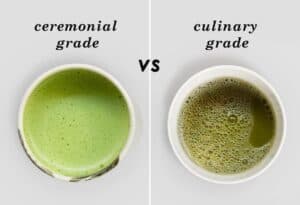
- The color of the tea powder is bright green and indicates the freshness and quality of the tea. Ceremonial grade matcha with high tea quality is brighter green than cooking matcha because it is the first harvested tea leaves that contain the highest levels of chlorophyll and L-theanine. Matcha powder that is yellowish green or not bright green indicates that it comes from older tea leaves, which are harvested from the bottom of the tea plant. However, some Japanese tea varieties that are grown with a lot of volcanic soil around them also affect the color of the tea. For example, Kagoshima matcha is known for having a slightly dark green color, while Seimei is a very bright green color.
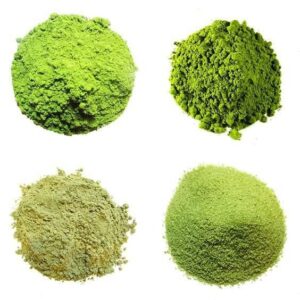 In addition to the above differences, if the tea leaves come from an organic tea plantation, the taste will be different from that of a normal tea plantation that may have used chemicals in planting. Precautions for choosing matcha for cooking that are available in the market today: if you choose a very cheap grade, it may taste too astringent and you may not even taste the matcha at all.
In addition to the above differences, if the tea leaves come from an organic tea plantation, the taste will be different from that of a normal tea plantation that may have used chemicals in planting. Precautions for choosing matcha for cooking that are available in the market today: if you choose a very cheap grade, it may taste too astringent and you may not even taste the matcha at all.
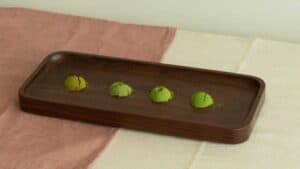
However, the two grades of matcha are designed for different uses and cannot be clearly compared. Matcha powder for cooking can also be divided into several sub-categories according to its usage. The choice of the two grades of matcha powder depends on your preferences and the results you want to achieve. Whether you want to eat it as ice cream, nama chocolate, pudding, cheesecake that has a clear tea flavor and green tea color, the highest grade of tea for cooking is suitable for use. The lower grades are used to make desserts that require a strong, bitter flavor, such as brownies, cakes, or soba noodles. Or if you only use the color and do not emphasize the clear flavor, you can use a lower grade of green tea to make bread and sprinkle it on the dessert. But if you want to brew it with plain water to get the umami flavor of the tea, it is recommended to use ceremonial grade tea. In addition to dividing tea grades by harvest, it can also be divided into 2 types according to the tea brewing method, called KOICHA and USUSHA brewing. See more at https://bit.ly/2RrD29N
Source
https://www.matchaeologist.com/blogs/explore/ceremonial-vs-culinary-matcha
https://naokimatcha.com/articles/ceremonial-gradematcha/
http://fullleafteacompany.com/products/matcha
Article from : Fuwafuwa
Iced Matcha Latte Iced Matcha Latte
Turn your cold green tea into a premium matcha latte, a popular menu item of the shop that is so delicious you have to tell others!!
Good quality matcha powder will give a beautiful green color. When poured over fresh milk, you will see a layer of emerald green gradually seeping down. The method of making it is not difficult. Especially if you have the equipment to help, it will not take long to brew. Let’s see the ingredients and brewing method. ^^
Dissolving aid
- Matcha powder sieve
- Chasen (茶筅) is a bamboo stick used to grind green tea powder to prevent it from clumping.
- Portable milk frother (Mini milk mixture)
- Shaker cylinder
Ingredients for a 16 Oz. glass.
- MATCHAZUKI Excellent Grade Matcha Powder 3 grams (~1.5 teaspoons)
- Warm water 40 ml
- Fresh milk 150 ml
- 10 ml syrup (~2 teaspoons)
- ice
Brewing process
1. Dissolve matcha powder in warm water by sifting matcha powder through a sieve into a cup or bowl, then pour in warm water and use a Chasen or milk frother to beat the tea powder into the water. Then set aside.
2. Add ice to another glass.
3. Add syrup according to desired sweetness.
4. Pour in fresh milk and mix with syrup.
5. Pour the dissolved matcha over the fresh milk.
Or you can watch a video on how to make it here ^^
*** If you don’t have a dissolving device, try this method.
———————————-
How to check if matcha powder is of good quality
With the popularity of matcha powder and green tea influenced by Japan, there are rapidly increasing sources of matcha powder and green tea leaves in Thailand, whether imported from Japan, China, or even produced in Thailand. The origin of each tea affects the different tastes and aromas. Another point to be careful about is not telling the true properties of the tea leaves. Every shop will say that it is original tea from Japan, so how can we know which shops have real green tea powder? You can observe these factors.
- The first thing to notice is color . The darker the matcha, the less bitter it will be. This is because it is a well-maintained matcha, a good variety, with a dark green color. It can be drunk directly as a thick brew (Koicha). It is recommended to use a lower grade of matcha powder used in baking because it will have a more intense flavor. When mixed with other ingredients, it will create a more intense flavor. Also, don’t forget to check the container or package that the tea is in. Good matcha powder has a shelf life of about 6 months and should be used up within 4 months after opening. If stored longer than that, the color will start to fade and the aroma will be less fragrant. This is because the tea leaves are steamed at high temperatures during the manufacturing process to stop the oxidation reaction. However, as time passes, the tea leaves are constantly exposed to oxygen, causing them to turn yellow, just like normal leaves that change from green to yellow.
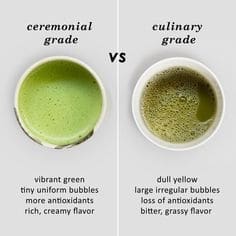
2. Ingredients: Some matcha powders are actually cheap. This is partly due to the fact that the matcha powder is mixed with flour, not pure green tea. This is why they can be so cheap. Don’t forget to flip the package to read the ingredients clearly before buying the wrong one.
3. Reviews from other customers: Don’t forget to check out reviews from people who have already purchased and consumed the product to see what delicious dishes it can be made into and how much to use. This will provide ideas and encourage those who read the reviews to buy it and try it out.

4. Source: Check the source clearly to see which city in Japan it comes from. For example, the most popular cities for green tea are Uji and Kyoto. However, Shizuoka is also equally famous. Knowing the source in detail will help us be more confident in the quality of the tea.
5. Price: Don’t forget to compare market prices to see if the tea you’re buying is too expensive or too cheap. Even if it’s a good quality tea imported from Japan, you should check prices from multiple sources. And don’t forget to check prices from Japan itself, because some products imported directly from the source are several times cheaper than those produced in Thailand. Green tea itself comes in many grades, and each grade has a different price. Checking the same grade will give you the clearest price range.
6. The seller’s name may not be a significant factor, but if you know the source, have a Line@ page, Facebook page, or a reliable website, this is another factor that will help build consumer confidence.
Just 6 simple things to be careful of and think about before buying to ensure you get good quality tea at a reasonable price.
Source
https://cookingchew.com/matcha.html
https://drericz.com/recipes/diy-super-greens-mix/
Article: Fuwafuwa
Come learn about the origins of matcha green tea powder.
It is said that green tea was discovered by Emperor Shen Nong, a scholar and herbalist who was very clean. He drank only boiled water. One day, while Shen Nong was resting under a tea tree in the forest and was boiling water, the wind blew the branches, causing the tea leaves to fall into the nearly boiling water. When he tried drinking it, he felt very invigorated. Green tea was gradually developed. Villagers also began to grow and develop tea, adding spices or flowers to create a different aroma and flavor. All tea grown in China is green tea. The production process involves combining tea leaves, steaming them, and drying them. These leaves do not store well, lose their aroma easily, and their taste is not good. In the 17th century, there was trade with Europeans. In order to preserve the quality of tea for a longer time, fermentation was carried out and drying them, which is the origin of oolong tea and black tea in China.
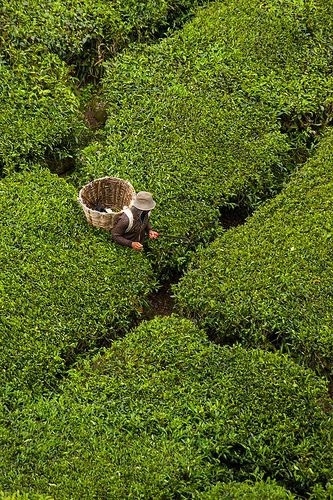
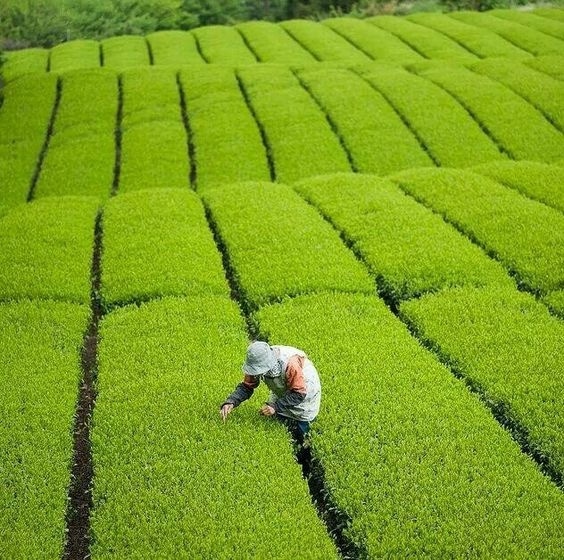
The introduction of tea to Japan began around the beginning of the Heian period. At that time, China and Japan had already established some contacts regarding Buddhism and culture. Japanese monks traveled as ambassadors to learn about various matters from China, including the study of Chinese herbal medicines. Thus, Chinese tea was first introduced to Japan by monks. It began with a monk from Aichi Prefecture who brought compressed tea (which had to be ground on a stone before being added to hot water to be drunk) and a small amount of tea beans to Japan. When the emperor visited the monks at his temple, the monks brewed a cup of tea and presented it to him. The emperor was so impressed by the taste that he ordered the tea beans to be planted in an herb garden within the imperial palace. Tea spread to the Kinki region (Kyoto), but its popularity remained limited to the upper classes.
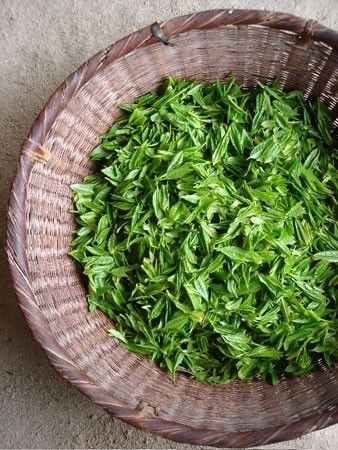
Later, in the early Kamakura period, Zen Buddhist monks brought back a large number of tea beans from China, along with the tea production process. The production method involved grinding the tea leaves in a stone mortar that generated minimal heat to preserve the unique flavor and aroma. This resulted in a fine powder, similar to flour, or what we call matcha powder . Making matcha powder takes a long time to produce a certain amount of tea powder, so the price is higher than other types of green tea. It also has a rather special brewing method, requiring a tea whisk to beat the leaves to dissolve them first.
At that time, tea cultivation was widely promoted for its medicinal use. In one of his books, he wrote, ” Tea is the foundation of the mind and the best medical tool, making life more fulfilling and complete.” Then, research began on tea’s properties, including its ability to quench thirst, improve digestion, and detoxify by eliminating toxins through urine.
During the Shogunate’s reign, Minamoto Sanemoto, suffering from heavy drinking, tried tea and his condition eventually disappeared. Later, monks began traveling to spread knowledge about tea throughout Japan, and tea became part of certain rituals and used for medicinal purposes.
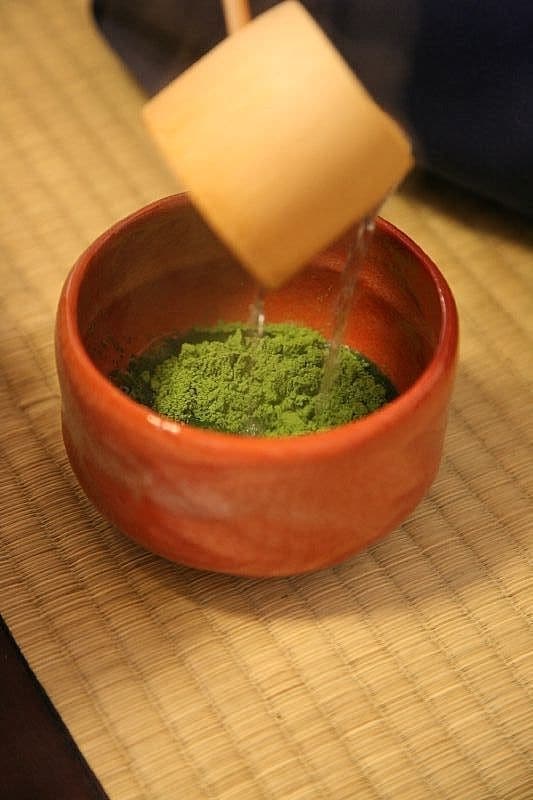
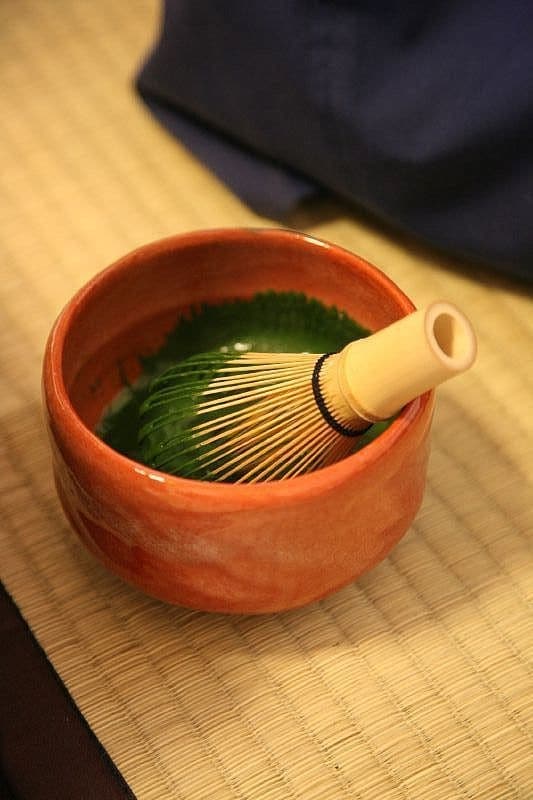
During the Muromachi period, the traditional Japanese tea ceremony, known as Chanoyu, began to be practiced. During this era, tea ceremony began to incorporate ideas, spirituality, and natural artistic creations. Detailed information began to be applied to the vessels used in the tea ceremony, as well as the serving of green tea in restaurants.
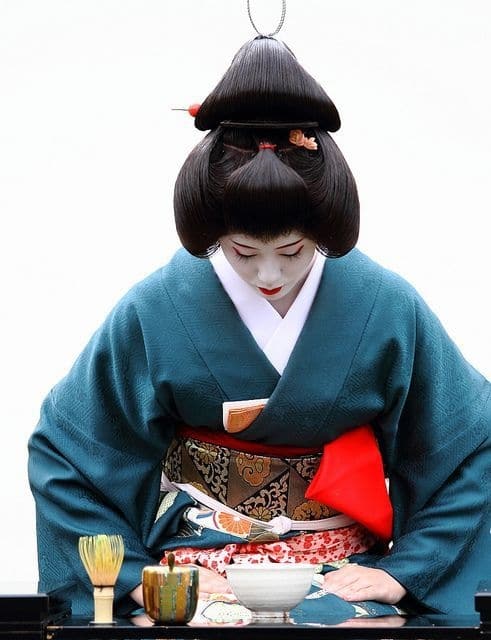
Drinking tea with the simple, focused mind of Zen allows the mind to develop completely. Priests therefore designed a small tea room to support the Zen ideals of tea ceremonies. This led to the emergence of the traditional Japanese tea ceremony as we know it today. Although the tea ceremony and tea drinking began to extend to the lower classes during the Edo period, the best tea harvests of the year were first handed down to the samurai class. The tea that the commoners drank was harvested later, and thus of lower quality. Later, as the tradition spread and social class divisions eased, the tea ceremony tradition has remained widespread to this day. In addition to training in meditation, the tea ceremony helps to calm the mind and allow one to be more present and inner-worldly. Some Japanese schools even teach the tea ceremony to Japanese children.
Source
http://fineartamerica.com/featured/oolong-tea-bud-jung-pang-wu.html
https://moyamatcha.com/en/moya-matcha/history-of-matcha/#
http://d.hatena.ne.jp/keibunsha2/20110508
https://www.pinterest.com/pin/339951471845392656/
https://www.flickr.com/photos/aligatorpics/6240407574/in/photostream/
http://japan-web-magazine.com/japanese-tea/japan-japanese-tea-ceremony0.html
https://traditional-japan.tumblr.com/image/153431720372
shorturl.at/brstQ
Article from: Fuwafuwa
Making dessert fillings from matcha green tea powder
The technique of modifying ingredients and recipes to create a variety of flavors is something that bakery and cafe owners should know. Sometimes, many people go to study baking, but when they want to modify the dessert they learned to create the desired flavors, they end up using the wrong ingredients.
When making green tea cream as a filling for desserts, some people prefer to buy ready-made ones that are already available on the market for convenience. However, the flavor, intensity, and color of the green tea may not be as intended.
Matchazuki would like to share how to make green tea cream easily. If you are a Hojicha tea lover, you can replace the green tea powder in the recipe with Hojicha tea powder in the same amount. However, I recommend using green tea powder for desserts because it is delicious, has a beautiful color, and has a better taste than using tea leaves.
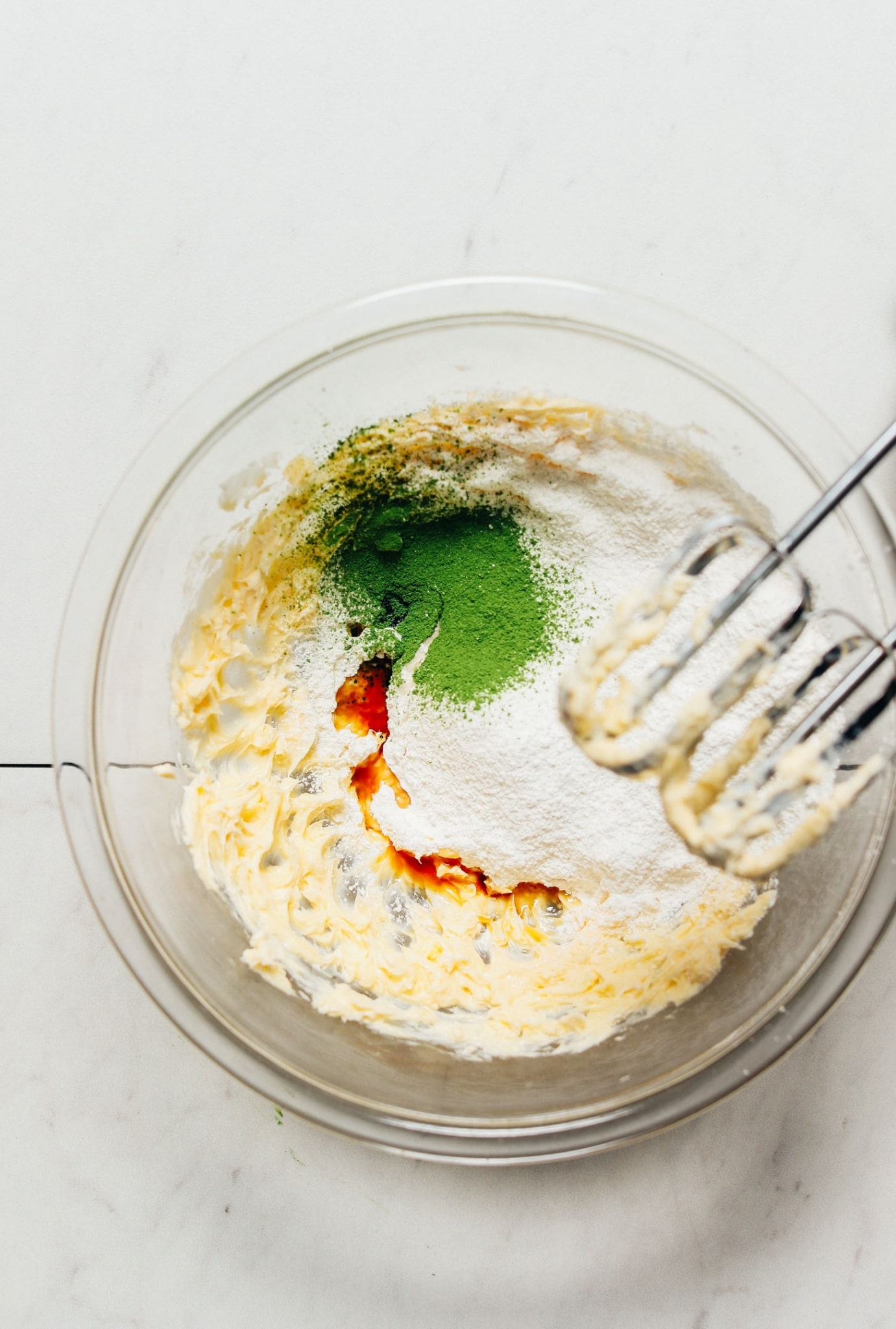
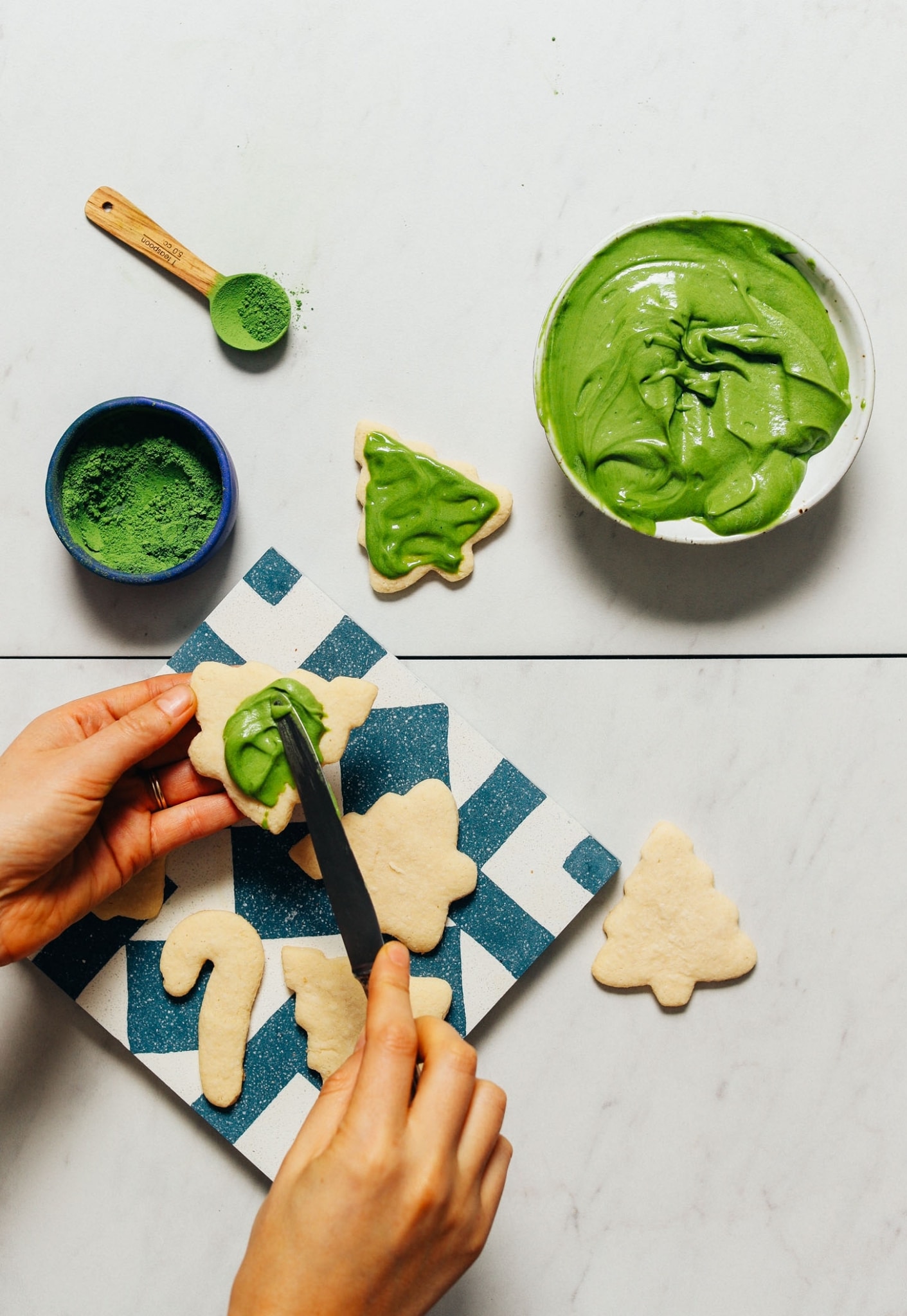
If you’d like to try making your own matcha custard filling, it’s easy to make. Simply heat 125 ml. of milk in a saucepan until lukewarm (not boiling). If steam rises, turn off the heat. Then, beat 1 egg yolk with 35 g. of sugar until pale yellow. Sift 13 g. of cake flour and 1/2 teaspoon of 5 g. of matcha powder into the mixture and continue beating. Gradually pour the warm milk into the saucepan. Heat over low heat, stirring constantly with a spatula until the cream begins to thicken. If you see bubbles rising, heat for another minute and turn off the heat. Then, add the butter and stir until melted. Pour the cream into a flat plate, cover with plastic wrap, and refrigerate for about an hour. This type of cream has a thick texture similar to that found in cream-filled buns, making it perfect for filling bread or pies.

But if it’s green tea cream, the texture is soft and smooth. It can be used as a filling for cakes like crepe cakes, cream puffs, or roll cakes. This type of filling has a light, soft, and smooth texture. You can eat it continuously without it being heavy or greasy because it’s made from just 3 simple ingredients: 400 ml. whipping cream, 1/3 cup of green tea powder, and 1/3 cup of sugar. Mix them together and beat with a whisk until soft peaks form. You can tell when soft peaks form by stopping the whipping and lifting the whisk. The cream at the tip of the whisk will bend down slightly. This type of cream is soft and smooth. It’s often used in Japanese-style bakery products. However, if you beat it for too long, our soft green tea cream filling will turn into a heavy cream that can be used to spread around the cake for decoration or to squeeze the cream into various patterns.
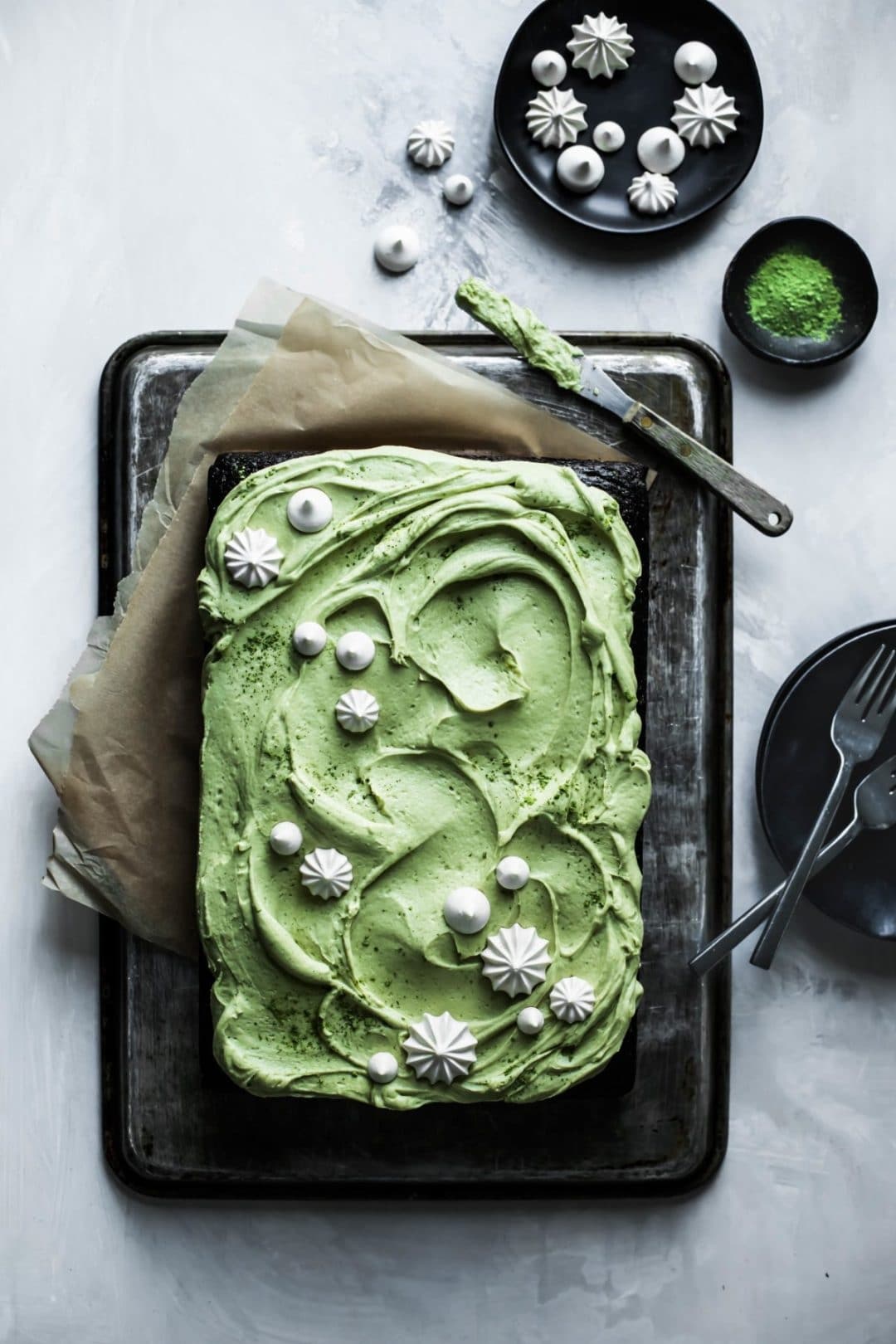
Or if it’s green tea spray to eat with bread, just mix 12 g green tea powder, 50 ml fresh milk, 150 ml fresh milk, 100 ml whipping cream, 40 g sugar together in a pot. Simmer over low heat for 15 minutes. You’ll notice that the mixture will reduce by 50% and become thicker.
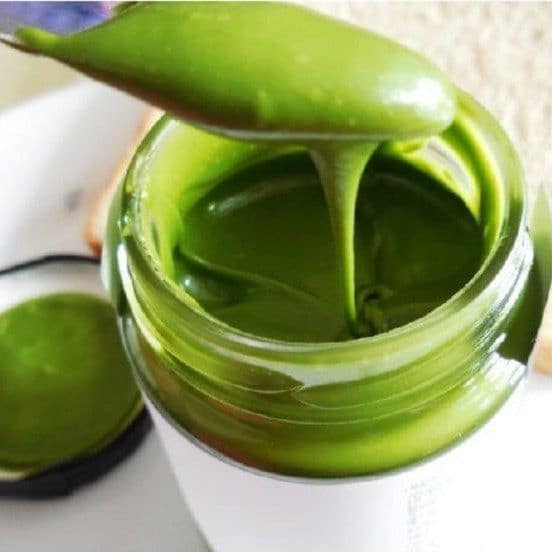
But if you want matcha lava filling, start by mixing 1 ½ teaspoons of gelatin powder with 2 tablespoons of water. Stir well and set aside. Then beat 2 eggs, ½ cup sugar, and 4 tablespoons of cornstarch together and set aside. Put 2 cups of milk, 1 cup of whipping cream, ¼ cup of matcha powder, and ½ teaspoon of salt in a saucepan over low heat. Use a whisk to mix until the matcha powder dissolves well. Then pour in the egg mixture and stir until the mixture thickens. Once the milk mixture thickens, turn off the heat. Then add the prepared gelatin and butter and stir to combine. Place in the refrigerator until cool. Then put it on bread, steamed buns, or any other desserts that you want to make into lava. This one has a lava filling because it uses butter in the filling. When you reheat it and cut the dessert, it will have a flowing lava texture.
If you have other dessert recipes you’d like to make with matcha flavor but aren’t sure where to start, such as with a chocolate filling, you can simply replace the same amount of cocoa powder with matcha powder. For a richer, more vibrant color, try adding 2-5 grams of matcha powder at a time to avoid overpowering the bitterness. If you’re allergic to cow’s milk, you can also replace soy milk with cow’s milk. Now, you can easily adapt and create a variety of desserts to please MATCHA lovers, without relying on pre-made fillings that may contain preservatives or artificial flavorings, or using artificial green coloring instead of pure matcha powder. 🙂
Source
https://www.proportionalplate.com/dalgona-matcha-latte/
http://www.matcha.my/Blog/matcha-milk-jam-recipe
https://www.oliveandartisan.com/ Making dessert fillings from Matcha powder
https://minimalistbaker.com/vegan-matcha-buttercream-frosting-1-bowl/
Article from: Fuwafuwa
Is a Chashaku (茶杓) Bamboo Spoon Really Necessary?
The matcha powder scoop, or Chashaku (茶杓), originated in the past when green tea from China was introduced to Japan. Japanese people used ivory tea scoops imported from China. However, in recent times, bent bamboo tea scoops have also begun to appear. It is believed that the person who invented the current shape of the Chashaku was Murata Juko, the first person to develop the Zen tea ceremony. The reason for choosing bamboo instead of ivory was because they wanted the tea scoop to be simple and not as extravagant as ivory, because the Zen sect has a simple idea based on Zen Buddhism.


The best features of Chashaku are that they are mostly made of bamboo and have a 1 cm wide spoon tip. In order to scoop the appropriate amount of tea powder, which is about 1 gram, in the tea ceremony, 2 grams of tea are used, meaning scooping the tea with Chashaku 2 times without using a scale. In addition, the handle should be 19 cm long. It is the perfect length for use in the Japanese tea ceremony.
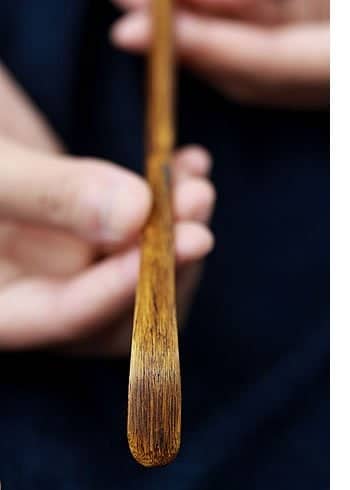
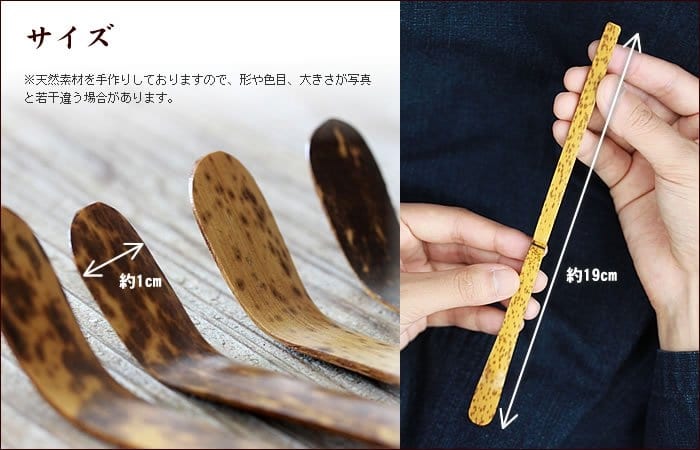
Scooping green tea powder to make tea can actually use a stainless steel spoon or other types of spoons. It is not necessary to use Chashaku, but you will see that many cafes and Japanese tea ceremonies prefer to use Chashaku because of the properties of bamboo. When it comes into contact with green tea powder, the taste will be consistent. And with the amount of tea that Chashaku can scoop each time, in addition, the bamboo of the Chashaku spoon also keeps the nutritional properties of green tea intact. It is easy to use by using a dry cloth or tissue to wipe the tip of the spoon dry before storing it in a box. It should not be washed with water. And Chashaku also gives a sense of authentic Japan. However, the Chashaku spoon is only for scooping tea powder. It is not for scooping other types of tea leaves.
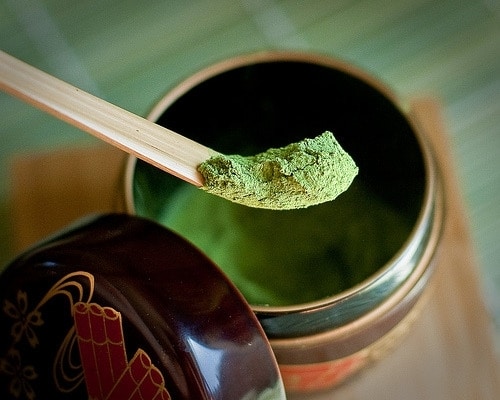
But nowadays, Chashaku spoons are increasingly made from other materials besides bamboo, following the changing times, such as stainless steel, metal, or other types of hardwood. Metal spoons have a rounded tip, similar to the common teaspoons we use for making desserts. However, you have to choose carefully because sometimes you can scoop up inconsistent amounts of tea.
Source
https://www.edenfoods.com/store/matcha-spoon.html
https://oideyasu.tumblr.com/post/64615700994
https://www.taketora.co.jp/fs/taketora/sa00235
https://www.pinterest.com/pin/353110427034464612/
Article from: Fuwafuwa
How do you sprinkle matcha powder on desserts to make them look delicious?
Normally, green tea used in baking can be either leaf or powdered. If using leaf, it must be brewed in hot water and the tea leaves filtered out before use. Therefore, we prefer to use powder because it has a wider range of uses. It can be used dry or brewed and then used in liquid form. Many people who choose to use powder to make desserts still have problems with decorating the desserts not turning out as expected.
Sprinkling matcha powder on the cake and it seeps into the cake is a normal occurrence because the tea powder will absorb moisture and become wet when left for a long time. Therefore, the color may not be smooth.
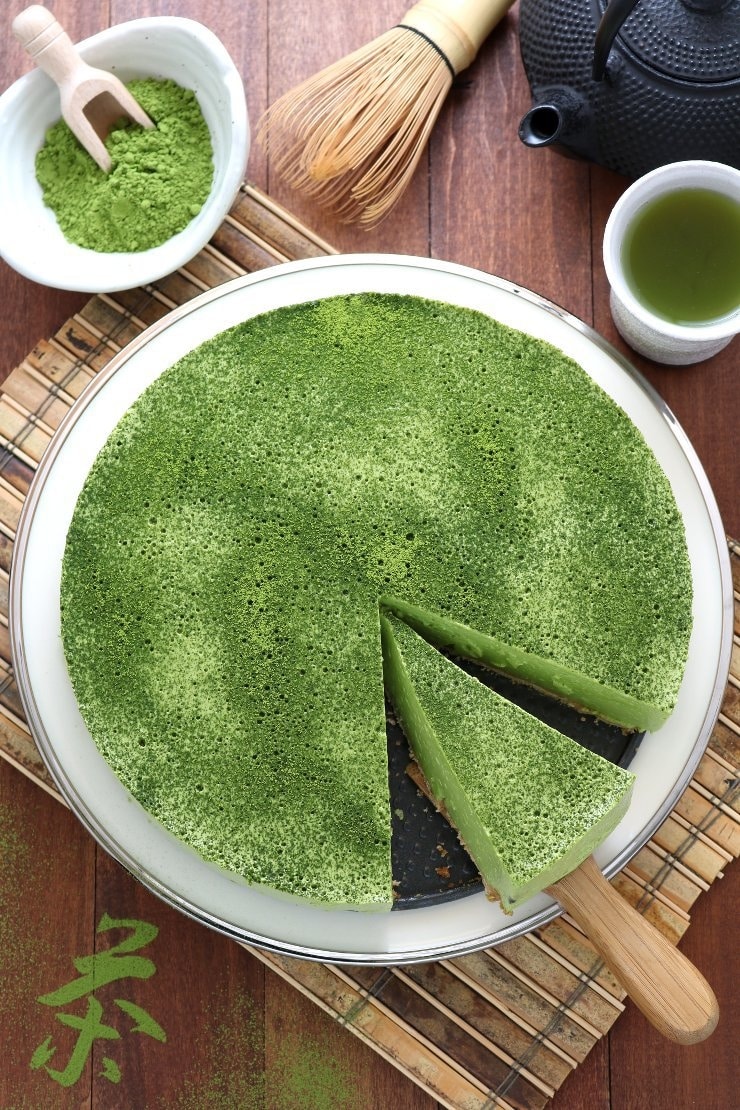
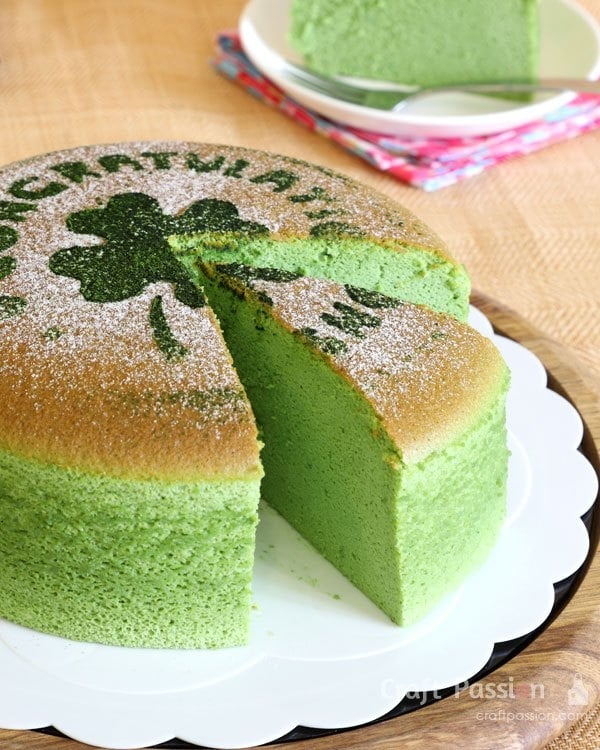
A little trick for decorating desserts is to sprinkle it on when you’re ready to serve or close to the time you’ll eat it to keep the green color uniform. It’s also recommended to sprinkle it on before you serve it with matcha powder. Leave the cake in the refrigerator without covering it. Let the cake dry for about 2 hours. This will make the matcha powder stick more easily and prevent it from melting and seeping into the surface. Or if you want to decorate the cake with patterns, after removing the cake from the refrigerator, place a sheet of paper over the cake without pressing it down. Then sprinkle the matcha powder through a fine sieve along the lined lines (this step must be done quickly).
However, some people mix matcha powder with a little icing sugar, which helps a bit, as icing sugar contains cornstarch, which helps to retain some moisture. Or, they use matcha powder specifically for sprinkling on top of desserts, but it’s more expensive than regular matcha powder and is available at Japanese bakeries.
For those who don’t have icing sugar, you can grind the sugar until it’s fine and mix in about 3% cornstarch. It will have the same consistency as icing sugar and can be used as a substitute.
Another caution when sprinkling matcha powder on desserts is the color, flavor, and aroma. The darker the matcha powder, the less bitter it will be, indicating well-preserved, high-quality matcha. Lighter greens indicate lower-grade tea leaves, produced from large, sun-exposed green tea leaves. Green tea connoisseurs will know right away which grade of green tea was used in their desserts. Another way to add value to your desserts is to write a short message stating the source of their premium matcha powder. This will significantly increase the value of your desserts, as some people don’t know whether the deep green color is real green tea powder or food coloring.
In addition, tea’s flavor is usually slightly sweet, slightly bitter, and slightly astringent. However, lower-grade teas tend to be more bitter and astringent. Therefore, choosing the right matcha powder to sprinkle on your desserts is another important consideration.

Source
Tastykitchen.com
http://cookingwithjapanesegreentea.blogspot.com/
https://www.justonecookbook.com/
http://www.landsandflavors.com/vegan-matcha-mousse-cake/
Article from: Fuwafuwa
Speaking of matcha, why does it have to be Uji matcha?
In Japan, products lined up in supermarkets and sweets in sweet shops that use matcha as an ingredient are advertised everywhere as using Uji matcha. Recently, people in Thailand have probably become more familiar with the name “Uji”. Have you ever wondered why it has to be Uji matcha and not other kinds of matcha?
- Definition of Uji Matcha
“Uji” is the name of a city in Kyoto Prefecture. The roots of Japanese culture have been here for over a thousand years, as evidenced by the World Heritage Site Byodoin Temple, but it is also the source of tea production in Japan. In the 12th century during the Song Dynasty of China, when the monk Eisai first brought tea and a millstone from China to Japan, it was brought to Kyoto. It can be said that the first tea drunk in Japanese history was matcha. As China abandoned this ancient drinking method and adopted the current hot extraction method, extracting the tea leaves.
But in fact, Uji tea today is not only grown in Uji City.
The Kyoto Prefectural Tea Bureau defines Uji tea as tea grown in four prefectures that have developed, taking into account their history, culture, geography, and climate: Kyoto, Nara, Shiga, and Mie. Tea is processed by the Kyoto Prefectural Tea Bureau in Kyoto.
In addition, the Uji Matcha registration defines matcha as the final processed tea from tea produced in the four prefectures in Kyoto Prefecture using methods originating from Uji. Therefore, Uji tea that is considered to be of excellent quality may actually consist of tea from the four neighboring prefectures mentioned above, but still retains the Uji character through the production method.
- The number one matcha production volume in Japan
In 2018, Japan produced 3,660 tons of Tencha (the term for the tea leaves used to make Matcha), of which one-third (1,200 tons) were produced in Kyoto. In addition, Nara Prefecture produced 250 tons, Shiga Prefecture 50 tons, and Mie Prefecture 150 tons. Based on the definition above, about half of Japan’s Matcha could come from “Uji tea”, showing that Uji matcha is produced from the largest source of Matcha in Japan.
- Won the competition by a landslide
The All-Japan Tea Festival (全国お茶まつり) is an event where people in the tea industry gather together once a year. There are various events and a national tea quality competition (全国茶品評会). The 73rd edition was held in Nishio City, Aichi Prefecture, from August 27 to 30, 2019.
For Matcha, the evaluation will be done in the form of leaves (Tencha). It will be considered from 5 aspects: 1. External appearance, such as color or shape, 40 points; smell, 65 points; color of tea water, 20 points; taste, 65 points; color of water from tea waste (this is only done for Tencha) 10 points; total 200 points.

The 73rd National Tea Quality Competition has only special award results, not tea grade scores. In the Tencha branch, tea produced in Kyoto won 5 out of 6 awards. In addition, for the Excellent Production Area Award, Uji City in Kyoto Prefecture came first, and Joyo City in Kyoto Prefecture came second. Last year, in the 72nd National Tea Quality Competition held in Shizuoka Prefecture, the tencha that received the highest score, with a full score of 200 points, came from Uji. Of the 34 teas evaluated as grades 1 through 3 (the rest were not awarded), 31 were from Kyoto, and 22 were from Uji. In the special award results, Kyoto Tencha took home all 6 awards.
- What about the taste?
Some people wonder, so how does Uji Matcha taste better than anywhere else? In fact, this is a difficult question because in Uji itself, there are many types of Matcha, each type has a different character depending on the strain or the manufacturer. The taste is naturally different. But one thing that indicates the greatness of Matcha is the umami taste (well-roundedness). It is a unique taste that is separate from the sweetness. The better the Matcha, the more the astringent and bitter taste that makes you frown will disappear into the umami taste. There are many Uji Matcha that achieve this level of quality.
The deliciousness of Uji Matcha does not end with the umami taste, the more the better, but also the balance of various elements such as aroma, bitterness, sweetness, and the feeling when drinking. This makes some people satisfied with Matcha with not much umami but the right amount of bitterness, are addicted to Matcha of lower grades (Matchazuki Classic does not give as much umami as the Excellent version, but the aroma is just as fragrant), or find that Matcha of lower grades is more suitable for making a certain type of dessert.
However, making matcha like this does not depend solely on the place where it is grown, but also on the skill of the person who blends tea from various places to perfection. However, if the raw materials such as the tea planted are not good, no matter how you blend it, you will not get excellent tea, right?
Now can you see how good Uji Matcha has a good profile? If you see anywhere that says they use matcha from Uji, you can be certain that the aroma and flavor are better and more expensive than regular matcha.
Article from: Vachi
Nutrients in matcha and healthy matcha intake
Before we reveal the answer, let’s take a quick look at the nutrients in matcha.
100 grams of matcha contains the following nutrients:
“Energy 324 kcal, Water 5 g, Protein 29.6 g, Protein from amino acids 22.6 g, Fat 5.3 g, 0.68 g, Triglycerides 3.3 g, Saturated fatty acids 0.68 g, Monounsaturated fatty acids 0.34 g, Polyunsaturated fatty acids 2.16 g, Cholesterol 0 g, Carbohydrates 39.5 g, Usable carbohydrates 1.6 g, Soluble fiber 6.6 g, Insoluble fiber 31.9 g, Total fiber 38.5 g, Ash content (inorganic food fraction) 7.4 g, Sodium 6 mg, Potassium 2700 mg, Calcium 420 mg, Magnesium 230 mg, Phosphorus 350 mg, Iron 17.0 mg, Zinc 6.3 mg, Copper 0.6 mg, Vitamin A beta-carotene 29000 mcg, Vitamin A1 2400 mcg, Vitamin E tocopherol 28.1 mg, Vitamin K 2900 mcg, Vitamin B1 0.6 mcg, Vitamin B2 1.35 mg, Niacin 4.0 mg, Vitamin B6 0.96 mg, Folic acid 1200 mg, Pantothenic acid 3.7 mcg, Vitamin C 60 mg, Caffeine 3.2 g, Tannin 10.0 g.”
Sorry for the length. Just read through it.
This information is translated from the Standard Nutrient List for Consumer Products, 7th Edition, 2015 (latest edition), produced by the Ministry of Education, Culture, Sports, Science and Technology, Japan. It is reliable and can be used as a reference.
Judging from this information, matcha is incredibly nutritious. Consuming a whole 100-gram jar shouldn’t be a problem, right? However, there’s one substance we should be especially wary of: caffeine.
100 grams of matcha contains 3.2 grams of caffeine, which means that 1 gram of matcha contains 32 milligrams of caffeine. For example, if you use a matcha tea with hot water, which normally uses a maximum of 2 grams, your body will receive 64 milligrams of caffeine.
So, how much caffeine should you be getting?
There is currently no established ADI (Acceptable Daily Intake) for caffeine. According to the recommendations of the European Food Safety Authority (EFSA), the appropriate daily intake of caffeine varies by age and body weight as shown in the table below.
| Age range | Appropriate daily amount | Recommended amount of matcha | Simple summary |
| 75 years and older | 22-417mg | 0.69-13.03g | Up to 2 tablespoons 1 teaspoon |
| 65-75 years old | 23-362mg | 0.72-11.31g | Up to 2 tablespoons, half a teaspoon |
| 18-64 years old | 37-319mg | 1.16-9.97g | Up to 2 tablespoons |
| 10-18 years old | 0.4-1.4mg/body weight (kg) | 0.01-0.0437gx body weight (kg) | – |
| 3-10 years | 0.2-2.0mg/body weight (kg) | 0.006-0.0625gx body weight (kg) | – |
| 12-36 months | 0-2.1mg/body weight (kg) | 0.006-0.03125gx body weight (kg) | – |
| pregnant women | 200 mg per day | 6.25 g per day | Up to 1 tablespoon, half a teaspoon |
According to the table above, for ages 12 months to 18 years, readers should calculate for themselves. Those who don’t have a measuring device may find it difficult, so I tried to see if I could change it to teaspoons, which everyone should be familiar with.
If you look at the picture below with the blue spoon, that’s a measuring spoon. 1 teaspoon of matcha is about 2.2-2.4 grams. As for the cover image, it’s measured from a measuring spoon. 1 teaspoon gives about 4.9-5.1 grams of matcha. These measuring spoons are easy to find. Try estimating them.
Caffeine intake is still a subject of research, and different organizations have come to different conclusions. For example, the New Zealand Food Safety Authority (NZFSA) says that healthy adults can consume up to 400 mg of caffeine per day (about two tablespoons and a little over a teaspoon of matcha). As new research becomes available, this number is likely to change, but if you’re going to believe Europe, the numbers in this table should give you a good idea.
What effects will the body have if it consumes caffeine?
There are so many studies on the benefits and harms of caffeine, and so many cases, that it’s hard to easily determine which type of person it affects. However, the Food Safety Commission of Japan (FSC), established by the Prime Minister’s Office, has compiled the following information about caffeine:
Taken in appropriate amounts: It stimulates the nervous system, relieves drowsiness, and relieves alcohol intoxication (be careful not to drink too much alcohol).
Received in excessive amounts:
- Central nervous system stimulation: dizziness, increased pulse, anxiety, tremors, insomnia.
- Stimulates the digestive tract: Stimulates diarrhea and nausea.
- diuretic
The World Health Organization also states that during pregnancy, the body clears caffeine from the bloodstream more slowly. Several studies have shown that consuming too much caffeine (the WHO figure is 300 mg per day – almost 2 tablespoons of matcha) can lead to delayed fetal development, lower birth weight, premature birth, and stillbirth. Therefore, it is recommended to limit caffeine intake to a reasonable level.
The Japan Beverage Industry Association also recommends against consuming caffeinated beverages while using pharmaceuticals containing caffeine.
No matter how nutritious a food is, consuming too much of it is not good. This applies even to matcha. Some people brew matcha in the traditional way (1.7-2.0 grams) and are hesitant to consume too much. I hope that after reading this article, everyone will be able to enjoy matcha with more peace of mind.
https://chakatsu.com/basic/caffeine_matcha/
Article from: Vachi
Matcha Ice-cream with Red Bean Matcha Ice-cream with Red Bean
Hello, everyone. How are you? The weather is getting hotter these days. Today, the MATCHAZUKI page, premium grade matcha green tea powder from Japan, would like to present a super easy menu to cool down, which is green tea ice cream with red beans. Of course, in hot weather like this, what could be better than ice cream, right? And eating it with red beans adds a rich sweetness, making it even more delicious. Let’s go see the ingredients and how to make it.
Key Ingredients
- 450 ml fresh milk
- 1 tablespoon MATCHAZUKI medium grade matcha powder
- 40 grams of granulated sugar
- A pinch of salt
- A little hot water
- Boiled red beans, as desired
Procedure
- Mix fresh milk, sugar and salt together and heat it up.
- Dissolve green tea powder in a little hot water and mix into the fresh milk mixture.
- Pour the mixture into the ice cream mold and add red beans as desired.
- Freeze for about 2 hours or until the ice cream is set. Insert the popsicle stick into the popsicle and continue to freeze until the ice cream is completely frozen.
This recipe for Matcha Red Bean Ice Cream is an easy recipe that is not complicated to make. It is a great way to cool down and you get the benefits of both green tea and red beans.
———————————-

